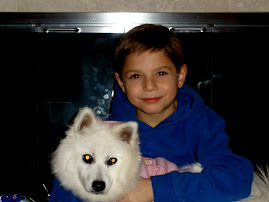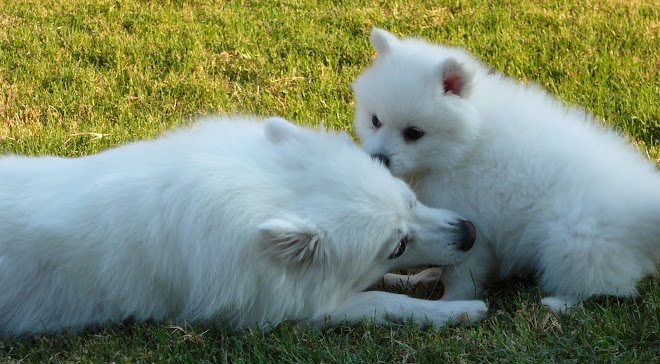May 2, 2010When cooking for your pooch, there are certain common foods that you should absolutely never-ever-ever add to the meal. Just like every one of us has seen our dogs eat something that would make us sick to our stomachs, we often eat things that could make our dogs very sick, sometimes fatally so. Since many Japanese Spitz tend to have finicky stomachs, they can be more uniquely sensitive to certain food toxins. It is because of this that you should keep a mental note of which of the most common human foods you shouldn't feed your dog.
Alcohol - Alcoholic beverages and foods containing alcohol should never be given to dogs. Alcohol attacks a dog's central nervous system.
Clinical signs of toxicity: Decreased coordination, nausea, vomiting, diarrhea, difficulty breathing, and abnormal blood acidity resulting in coma and possibly death.Avocado -Avocados contain a toxic ingredient called Persin, which is a fatty acid derivative.
Clinical signs of toxicity: Difficulty breathing, diarrhea and vomiting, abdominal enlargement, abnormal fluid accumulations in the chest, abdomen and sac around the heart, possibly resulting in congestive heart failure and death. Caffeine - Caffeine and Coffee beans contain methylxanthines, a cardiac stimulant.
Clinical signs of toxicity: Vomiting and diarrhea, panting, excessive thirst and urination, hyperactivity, abnormal heart rhythm, tremors, seizures and possibly death.Chives -
Onions, Chives, Garlic and Shallots (as well as close relatives to this group of vegetables, such as leeks) contain a significant amount of N-propyl disulfide and thiosulphate. This causes the red blood cells to burst while they circulate in the body, which can cause anemia.
Clinical signs of toxicity: Gastrointestinal irritation, blood in the urine, rapid heartbeat, excessive panting, lethargy, and anemia-related symptoms.Chocolate - Most dog owners know that chocolate is bad for their dogs, but they don't understand why. Chocolate contains substances called theobromine & methylxanthines (also foundin cacao beans).
Clinical signs of toxicity: Early on, your dog may become excited, agitated, nervous or hyper. Your dog may also have muscle tremors, vomiting, increased thirst and diarrhea. Your dog may also feel very hot. From there, symptoms could progress to coma. Some dogs have died almost immediately, presumably due to fatal cardiac arrhythmia.Coffee -
Caffeine and Coffee beans contain methylxanthines, a cardiac stimulant.
Clinical signs of toxicity: Vomiting and diarrhea, panting, excessive thirst and urination, hyperactivity, abnormal heart rhythm, tremors, seizures and possibly death.Garlic -
Onions, Chives, Garlic and Shallots (as well as close relatives to this group of vegetables, such as leeks) contain a significant amount of N-propyl disulfide and thiosulphate. This causes the red blood cells to burst while they circulate in the body, which can cause anemia.
Clinical signs of toxicity: Gastrointestinal irritation, blood in the urine, rapid heartbeat, excessive panting, lethargy, and anemia-related symptoms.
Grapes / Raisins - Though grapes and raisins are extremely toxic to dogs, especially if ingested in large quanities, the exact toxic agent is still unknown. The most likely suspect is a form of fungal toxin.
Clinical signs of toxicity: Kidney failure, possibly resulting in death. Note that dogs who already have certain health problems may show more severe signs of poisoning.Leeks - Onions, Chives, Garlic and Shallots (as well as close relatives to this group of vegetables, such as leeks) contain a significant amount of N-propyl disulfide and thiosulphate. This causes the red blood cells to burst while they circulate in the body, which can cause anemia.
Clinical signs of toxicity: Gastrointestinal irritation, blood in the urine, rapid heartbeat, excessive panting, lethargy, and anemia-related symptoms.Macadamia Nuts -
This is one of the scariest poisons because even the smallest of quantites can cause temporary paralysis, and, similar to grapes, the exact toxic agent is currently unknown.
Clinical signs of toxicity: Weakness, depression, vomiting, tremors, hyperthermia, and paralysis. Signs usually appear within 12 hours of ingestion and last approximately 12 to 48 hours.
Milk -
The toxic agent in milk is lactose. Dogs do not possess significant amounts of lactase, which is the enzyme that breaks down lactose.
Clinical signs of toxicity: Diarrhea or other digestive upset.Onions - Onions, Chives, Garlic and Shallots (as well as close relatives to this group of vegetables, such as leeks) contain a significant amount of N-propyl disulfide and thiosulphate. This causes the red blood cells to burst while they circulate in the body, which can cause anemia.
Clinical signs of toxicity: Gastrointestinal irritation, blood in the urine, rapid heartbeat, excessive panting, lethargy, and anemia-related symptoms. Potato Leaves & Stems - Rhubarb Leaves, Tomato Leaves and Potato Leaves are some of the most dangerous plants for dogs to ingest. The leaves of these vegetables contain soluble calcium oxalates, which, when ingested, can lead to death of not treated fairly quickly. Also known to cause bladder stones. Note that the actual potatoes are fine, but you should avoid the skin, as it can contain poisonous alkaloids (Solanum).
Clinical signs of toxicity: Excessive drooling, tremors and kidney failure. Rhubarb Leaves - Rhubarb Leaves, Tomato Leaves and Potato Leaves are some of the most dangerous plants for dogs to ingest. The leaves of these vegetables contain soluble calcium oxalates, which, when ingested, can lead to death of not treated fairly quickly. Also known to cause bladder stones.
Clinical signs of toxicity: Excessive drooling, tremors and kidney failure. Salt - Large amounts of salt can produce excessive thirst and urination, or even sodium ion poisoning in pets.
Clinical signs of toxicity vomiting, diarrhea, depression, tremors, elevated body temperature, seizures and even death.Shallots - Onions, Chives, Garlic and Shallots (as well as close relatives to this group of vegetables, such as leeks) contain a significant amount of N-propyl disulfide and thiosulphate. This causes the red blood cells to burst while they circulate in the body, which can cause anemia.
Clinical signs of toxicity: Gastrointestinal irritation, blood in the urine, rapid heartbeat, excessive panting, lethargy, and anemia-related symptoms.Tomato Leaves & Stems - Rhubarb Leaves, Tomato Leaves and Potato Leaves are some of the most dangerous plants for dogs to ingest. The leaves of these vegetables contain soluble calcium oxalates, which, when ingested, can lead to death of not treated fairly quickly. Also known to cause bladder stones. Note that actual tomatoes are fine, though some dogs may be sensitive to the acid tomatoes contain.
Clinical signs of toxicity: Excessive drooling, tremors and kidney failure. Xylitol - Xylitol is used as a sweetener in many products, including gum, candy, baked goods, human toothpaste, and some breath mints. Though it is not something one would typically add to homemade dog food, I felt it was important to include it in this list due to its harmful nature. Xylitol causes insulin release in dogs. The increase in insulin leads to hypoglycemia (lowered sugar levels), possibly resulting in liver failure.
Clinical signs of toxicity: Vomiting, lethargy and loss of coordination. Signs can progress to recumbancy and seizures. Elevated liver enzymes and liver failure can be seen within a few days. Yeast Dough - Yeast dough can rise and cause gas to accumulate in your pet’s digestive system. This can be painful and can cause the stomach or intestines to rupture, if large amounts were ingested. Additionally, as the dough rises in your dog's stomach, the yeast ferments. The fermentation results in alcohol, which can cause alcohol toxicity (See Alcohol above). Because the risks diminish after the dough is cooked and the yeast has fully risen, pets can have small bits of bread as treats.
Clinical signs of toxicity: Distended abdomen, abdominal pain.It is important to note that this is NOT a complete list of human foods that are toxic to dogs. So, before adding a new ingredient to your canine's dinner recipe, make sure that the ingredient is safe by checking it out here:
http://www.aspca.org/pet-care/poison-control/.
It is also important to note that many dog food recipes on the internet and in canine cook books can contain foods that may be toxic. I have found many recipes online that contain onions and garlic. So, don't blindly follow recipes that you find.
IF YOU SUSPECT YOUR PET HAS BEEN POISONED BY A TOXIC INGREDIENT, CONSULT YOUR VETERINARIAN IMMEDIATELY. If your vet is unavailable, these three national pet-poison information centers may be able to help. All charge a flat fee.
 October 30, 2010
October 30, 2010 October 22, 2010
October 22, 2010

























